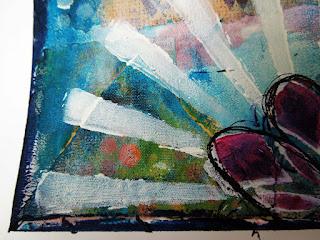This week's bonus lesson in LifeBook came from the lovely
Alisa Burke. Although there was no project to complete, we did get a challenge to use our existing art supplies in new ways to maximize their potential. This was challenge was right up my street! When I first became interested in art, over a year ago now, I did nothing but experiment! I seriously wondered whether I would actually make any art rather than just play with my supplies. I still buy things out of curiosity rather than necessity, just so I can play with them.
The other day I saw a review about the
Cretacolor Aquastics, which are water-soluble oil pastels. I just had to have them even though I already have the Neocolor II's, the Inktense blocks, the Gelatos and the Portfolios, along with a few other cheaper brands of similar products. But they are all slightly different from each other - with different properties and colours. This lesson came just at the right time for me to experiment with my new oil pastels.
I took a sheet of watercolour paper and started to explore the different ways I can use these crayons. Here's a list of methods I could think of along with my observations:
- use them dry (they are rather soft and glide well on the paper)
- use a wet brush to activate their water-soluble properties on the paper (they are not as easy to activate as Neocolor II's, but easier than Portfolios or other water-soluble oil pastels I have.)
- dip the tip of the pastels into water and draw with them (they are darker and more vibrant this way)
- take the colour straight from the tip of the pastels with a wet brush (again, they're not as readily soluble as neocolor II's, I don't think I'll be using this technique much)
- smudge them with dry fingers (they're not at all smudgable!)
- smudge them with wet fingers or with gesso (this works much better)
- mix them with gesso (this produces some nice muted, pastel tones)
- spray water on a rubber stamp and use the pigments from the pastels for stamping (this works quite well!)
- lay down the pastels dry and use a stencil to activate them with water (pretty cool effect!)
- activate a layer of pastels with water then use a stencil to remove the colour with a paper towel. (also pretty cool!)
- draw over a stencil and activate with water while the stencil is still in place (nice!)
- use two or more co-ordinting colours dry and blend them with water or gesso to make different shades of colours (nice blends!)
- heat them with a heat gun (they don't really melt, which means, there's probably not much oil in them)
- use them for outlining dry or wet (this is probably what I will do most of the time, as they are quite thin, so I can draw thinner lines with them)
I'm sure there's lots of other ways to use them, but this is as far as I got. I'll share my scribble/test page with you, which I then turned into a proper journal page not wanting to waste the precious watercolour paper. I used the cool technique of layering I learned in
week 39 from Roben-Marie Smith, which has now become my go-to method of turning anything on paper into a journal page!
I only used scraps of collage papers and some pieces of fabric lying around on my desk to make a collage, which I then, gessoed, painted and stencilled over. The elephant stencil is from Clarity Stamps. The author of the quote is unknown. This page was not part of the lesson, but I really didn't want to waste that paper! If you know of any other ways of using these oil pastels, let me know in the comments below!
Sorry about the amount of photos to follow, but I really love the colours and textures in this page and I just couldn't stop myself! Hope you have a fast internet connection and you get as much joy out of them as I do!
 |
| My oil pastels test sheet |
 |
| scrap collage pieces added |
 |
| paint and stencils added |
 |
| finished page complete with elephant, flowers, quote and doodles |

















No comments:
Post a Comment
I would love to hear from you. Please leave a comment below.